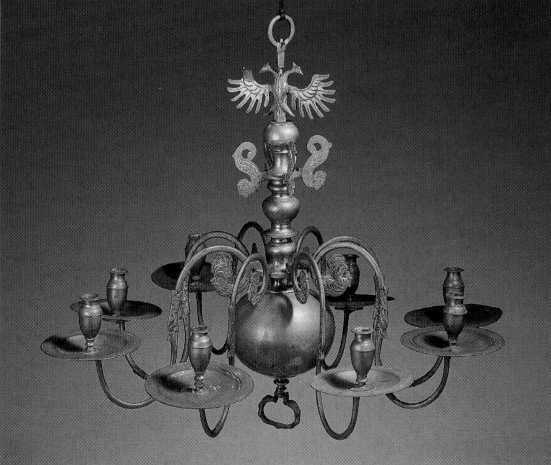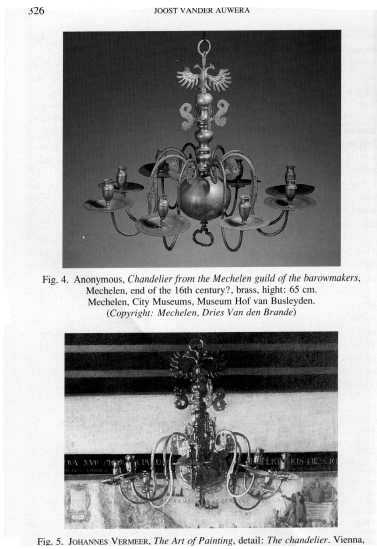

Literature on this particular chandelier: 'Taking local history seriously. The case of the chandelier in Saint Luke Painting the Virgin by Abraham Janssens van Nuyssen and in The Art of Painting by Johannes Vermeer van Delft' in Liber Amicorum Raphaël de Smedt, number 2 in series Artium Historia, Joost van der Auwera ed., published by Peeters, Leuven / Louvain, Belgium, 2001
 The
chandelier which is chown in The
Art of Painting probably dates from the end of the sixteenth
century, as does this one from Mechelen, Belgium. On page 323 he
author states that the bird on top is not an eagle but a phoenix
(compare the Arnold Bon poem on Fabritius and Vermeer as mentioned by
Blankert, Vermeer, 1975/1978)
The
chandelier which is chown in The
Art of Painting probably dates from the end of the sixteenth
century, as does this one from Mechelen, Belgium. On page 323 he
author states that the bird on top is not an eagle but a phoenix
(compare the Arnold Bon poem on Fabritius and Vermeer as mentioned by
Blankert, Vermeer, 1975/1978)
The chandelier has been exhibited early on in Delft and later on in Ghent in 1961 but a photo has probably not been published in Vermeer literature until now. An astonishing comparison indeed!
Van der Auwera's central thesis is that the chandelier has a deep meaning within the complex Vermeer painting (and he gives ample documentary proof in contemporary paintings and books): "Still without light, it represents the first necessary but not yet sufficient phase of the training program of the painter, who portrays himself as such: in his studio and surrounded by the tools of his trade."(p.332).
It is most likely Vermeer never owned such a costly chandelier. He documented existing objects and combined these into paintings full of invention (and not 'photography").
Note : This object was NOT part of the Vermeer-inventory as listed by the clerk working for Delft notary public J. van Veen. He made this list on February 29, 1676, in the Thins/Vermeer home located on Oude Langendijk on the corner of Molenpoort. The painter Johannes Vermeer had died there at the end of December 1675. His widow Catherina and their eleven children still lived there with her mother Maria Thins.
The transcription of the 1676 inventory, now in the Delft archives, is based upon its first full publication by A.J.J.M. van Peer, "Drie collecties...", Oud Holland, 1957, pp. 98-103. My additions and explanations are added in square brackets [__]. Dutch terms have been checked against the world's largest language dictionary, the Dictionary of the Dutch Language (Woordenboek der Nederlandsche Taal , or WNT), which was begun by De Vries en Te Winkel in 1882.
This page forms part of a large encyclopedic site on Vermeer and Delft. Research by Drs. Kees Kaldenbach (email). A full presentation is on view at johannesvermeer.info.
Launched December, 2002; Last update March 2, 2017.
Back to the Welcome page: click Welcome.